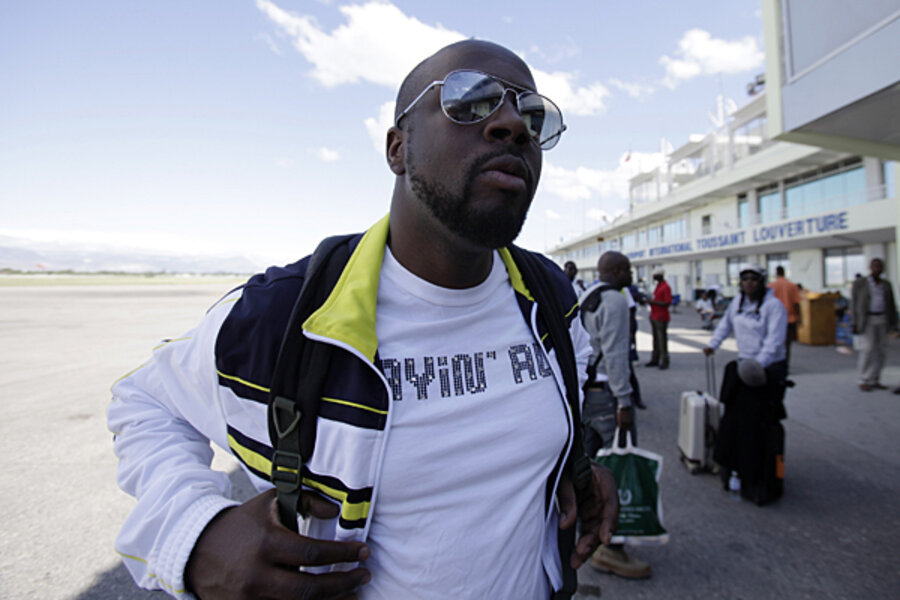Wyclef Jean Yéle relief: Is this best way to help Haiti?
| Boston
Hatian-born Pop superstar Wyclef Jean’s Yéle Haiti Foundation raised more than $400,000 via text messages for aid survivors of the earthquake that rocked the island nation Tuesday. But for people eager to help Haiti in the aftermath of Tuesday's devastating earthquake, are groups like Yéle the best bet?
Probably not, say emergency relief experts and groups who track the effectiveness of charities.
That's not a knock on all the good work Yéle and groups like it have done in the past, but a reflection of the fact that larger and long-standing aid groups have the logistical expertise and staff on hand to manage the chaos of large-scale relief operations, when simply getting aid into the hands of the needy can be a daunting challenge and keeping track of resources and staff are a constant battle.
That background helps control costs and means you get more bang for your charity buck if you're interested in immediate relief. Smaller groups like Yéle work best when the situation is more stable, say experts, when they fill in program gaps in education and other areas that are often overlooked by the heavyweights.
Carlos Castillo, a former administrator at the Federal Emergency Management Administration (FEMA) who now works at PricewaterhouseCoopers, argues in a press release Thursday morning that charitable giving should go to established organizations. "They know what’s needed, how to get it there and ensure it gets to the people that need it most,'' the release says.
According to tax forms filed by the Yéle foundation, 73 percent of the organizations funding went to its programs in 2007, the last year for which data is available. The group put 65 percent and 61 percent of its revenues toward programs in 2006 and 2005, respectively.
In contrast, roughly a quarter of the group’s funds went toward administrative and fundraising costs during 2006 and 2007. Over 40 percent of Yele’s 2006 expenditures were eaten up by administration and fund-raising appeals. Yéle did not respond to an e-mail message seeking comment.
Is bigger better?
Bigger, more established aid organizations do a better job of controlling these costs.
For instance, Direct Relief International, a humanitarian group based in Santa Barbara, Calif., spent over 98 percent of its revenue on programs between 2006 and 2008. But that group’s huge revenues ($198 million in 2008) tower over those of Yele, which took in $569,000 in 2007. CARE, an Atlanta-based humanitarian organization, spent over 90 percent of its roughly $650,000,000 in annual revenue on programs between 2006 and 2008.
Some smaller group's also do a better job than Jean's organization. Beyond Borders, a Haiti-focused humanitarian group based in Norristown, Penn., spent over 90 percent of its roughly $948,000 and $866,000 in annual revenue in 2008 and 2007 on programs. Hope for Haiti Children's Center, an Orlando, Fla.,-based group supporting Haitian orphans, spent about 85 percent of its roughly $1 million in annual revenue over the same period.
To be sure Bennett Weiner, COO of the Better Business Bureau’s Wise Giving Alliance, says that ratios don’t tell the whole story of a charity’s effectiveness.
“With ratios, there’s a certain difference in expectation for a very large organization to one that’s much smaller,” Mr. Weiner says. “That’s just a fact of how organizations operate, but that doesn’t mean that the smaller organization isn’t doing work that’s needed or working in a helpful niche that’s not being addressed.”
On Yéle's website, the group claims “100 percent of funds raised (will) go to the relief operation.” Claims such as this should be taken with a grain of salt, Weiner says.
“There are always going to be some overhead expenses — there is going to be a transaction expense for a credit card donation. So when those types of messages are made about 100 percent going [to a group’s work], even if the charity is getting its other money to pay for those expenses, the fact is the expenses are still there,” Mr. Weiner says.
When choosing a charity working in Haiti, Weiner says that prospective donors should first vet organizations online. Sites such as the BBB’s Wise Giving Alliance site and CharityNavigator.org offer a wide variety of statistics and ratings of charitable groups.
Then they should consider the stage of the recovery effort — and keep attuned to it as the situation develops.
“This tragedy is not one that’s going to go away next week. It’s going to be a long-term recovery and there are going to be immediate needs that need to be addressed such as search and rescue and medical care but there are going to be long-term needs,” Weiner says. “There are going to be a lot of opportunities down the road as well and organizations are hoping that people will continue to give and not just move on to the next issue.”
Follow the Global News Blog for updates on Haiti throughout the day.





